|
|
Sailing With Style
American Sailing E-News September 2012

|
Greetings!
September's a busy time for ASA! Sailing season continues, with the leaves turning and the last few weeks of summer hanging around before it officially ends on the 22nd. But the action doesn't end with the equinox. We have flotillas in Croatia and Southwest Florida, and a look ahead at some of our winter sailing events in the Caribbean! Find all that and more in this issue of 'Sailing with Style.'
Please enjoy, and email us with your suggestions so that we can continue to improve it. We hope to see you
at one of ASA's flotillas, member events, or regional
boatshows soon! Sincerely,

Charlie Nobles
Executive Director |
Photo of the Month
for September 2012

Sunset over the "Sleeping Lady of Poros," Greek Islands.
By Athens Sailing Academy |
Check it Out!
Our New Coastal Cruising
Made Easy 103 Textbook
ASA is proud to release Coastal Cruising Made Easy, which will serve as the new official textbook for the ASA's Basic Coastal Cruising Standard course, ASA 103. Published in full color and containing striking world-class sailing photography from adventure
photographer Billy Black, Coastal Cruising Made Easy features include a water-resistant cover, an extensive glossary of sailing terms, and a unique and definitive layout of full two-page diagrams throughout the book. This easy to read teaching tool
follows the critically acclaimed Sailing Made Easy, released in
2010, which has become the new industry standard in sailing education.
Click here to buy. ASA members save 20% with
member savings coupons. Don't have a coupon?
Email Kathy to get one.
|
|
Cooking Adventures at Sea
All the adventure is not just on the foredeck!
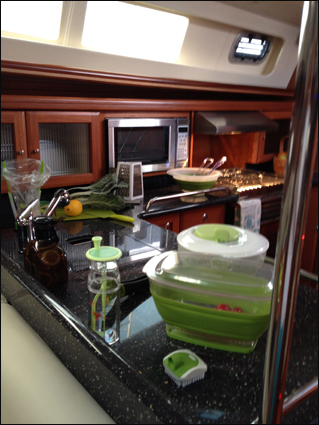
by Captain Stacey Brooks, ASA Instructor and
Sea Dog Sailing School Owner
Let's all be truthful......living aboard sailboat can be lovely and can be romantic but all of us who are true sailors know that at the heart of this lifestyle there is a great challenge. Galley organization and preparation is key. The following tips will help you organize, eat healthy and make sure you are safe in the galley as well.
Cooking Tips
Galley kitchens are not the life of the party that a home kitchen can be. The best cooking in a galley is quick, with minimal prep and clean-up. Safety is very important when out on a boat, as the doctor may be some distance away.
- Only cook when the boat is docked or anchored--this includes grilling. There will still be some movement, but it should be more predictable.
- Check all propane tanks for leaks and refill before setting off.
- Conserve water. It is not only used for cooking, but also for cleaning and for flushing the head. Bring bottled water for drinking. Salt water may be used for cleaning.
- Keep things put away in cupboards, pouches or bags so they don't go flying if a wave comes along unexpectedly. This also makes things easy to find.
- Have dish soap for washing dishes; paper plates and cups can be useful, but fill up your trash bin. Bring plenty of paper towels and trash bags for keeping things tidy.
- Boiling water is dangerous on a moving vessel. Prepare rice and pasta ahead of time, cool, and store in freezer-weight bags. Many foods such as pasta and rice can also be frozen in muffin cups for perfect portions.
- This also helps to conserve both water and fuel.
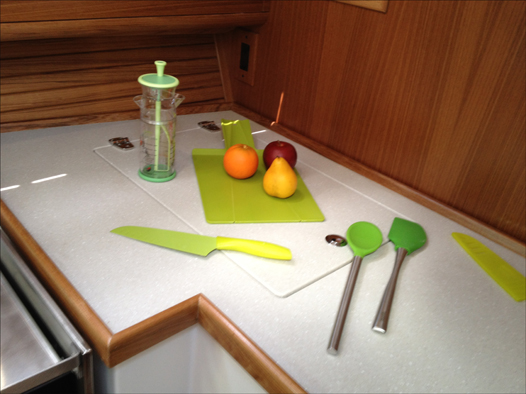
Equipment and Safety
- There are special grills available that attach to the railing of the boat--perfect if you are catching fish to eat.
- Counter space and preparation areas are usually minimal, so avoid bringing food that involves a lot of chopping or do this preparation at home and bring them onboard pre-measured for your recipe. Find a cutting board that clamps onto something or folds down from the wall to create a prep area. Some cutting boards clamp onto the railing of the boat and can be set up next to the grill. There are also a variety of cutting boards available that give you plenty of chopping surface and still stow easily while underway.
- Be sure to bring a spatula, mixing spoon, can opener, corkscrew and bottle opener. These items should be made of durable materials such as high quality stainless steel, heat resistant nylon and silicone. Knives are necessary for food prep, but can be a hazard if you leave them on the counter. Hang a magnetized strip for storing knives and put them away after each use. Many knives also come with protective sheaths for safe and convenient storage.
- For dishes and utensils, use Melamine, Bamboo, lightweight plastic or metal. Things can move around quite a bit on a boat; having unbreakable dishes is safer and they usually float if they happen to fall overboard.
- Even when docked, a boat does move, so you will want to have safety railings on the front of the stove, oven (if available) in the ice box (if present), and in any cupboards.
Safety latches on cupboard and icebox doors usually come with the equipment, but may need replacing before setting sail. Strategically placed handles may be installed near the stove to help you keep your balance while the boat is rocking.

Meal Planning
With a little bit of forethought, you can save yourself time and trouble when preparing meals in your miniature kitchen. Many items can be prepared in whole or partially on land before you set sail. Review your menu plan and do your chopping and measuring before you sail. Place everything in airtight plastic containers or zip-top bags clearly labeled with the contents and the recipe name. By doing this, you can easily reach into the refrigerator and find just what you need to prepare the recipe.
- Make a list with one dinner for each night you will be out. Choose simple one-dish meals if possible.
- Plan to have sandwiches for lunch and hand-held items for breakfast: muffins, granola bars, or energy bars. Bring some eggs to scramble and serve in tortillas for breakfast, lunch or dinner. You can also prepare some hot dishes ahead, such as sloppy joes, spaghetti etc. and freeze or refrigerate in portion sizes. Then simply remove and heat.
- Don't rely on catching fish to eat. Consider fish a bonus meal or just replace one of your non-perishable meals.
- Your main source of fuel will most likely be propane. Since you can only bring so much fuel on board, plan your meals ahead of time and estimate your fuel needs before embarking on your adventure.
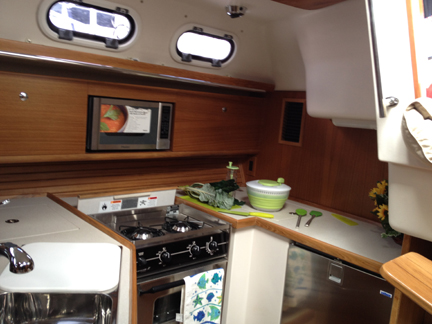
Galley design and products by the Yachting Gourmet
Using Space Wisely
The galley in a boat is a tiny part of an already tiny space. You may not even be able to stand up all of the way if your galley is really small. A miniature kitchen is cute until you try to fit everything (including yourself) inside.
- Bring only the minimum of cooking equipment: 1 skillet, 1 pot or saucepan, cups, plates, bowls and silverware. And, there are a lot of boating-friendly collapsible and multi-use items available today that can really save that valuable space while giving you the tools you need.
- There may be an icebox, but you should pack a cooler for drinks and any food overflow. The cooler also makes a nice chair to sit on, or a table to set your cutting board on while preparing food.
- There are a lot of storage accessories available at boating stores. Pockets for organizing can be attached to the wall for storing silverware, spices and tools such as bottle or can openers. Hanging nets can hold fresh produce.
- Attach lids of jars to the underside of the cupboard with screws: the jar can be screwed on or off for storage and access. (This is great for spices.)
The Following recipes are healthy, hearty and easy to prep and cook on any boat. Best of luck and happy cooking!
Mediterranean Bliss
Kalamata Pork Tenderloin with Rosemary, served with pita bread and a tomato-mozzarella salad. Pack some store-bought baklava for dessert.
Tips
- Purchase pork tenderloin that comes packaged in a vacuum-sealed pouch--it will keep longer in the cooler.
- Store tomatoes at room temperature; hang them in a mesh bag in the galley.
Original Recipe Yield 4 servings
Ingredients
- 1 pound pork tenderloin medallions
- 1/4 cup all-purpose flour
- 1/2 teaspoon salt
- 1/4 teaspoon pepper
- 1 tablespoon olive oil
- 1 tablespoon chopped fresh rosemary
- 1 clove garlic, minced
- 1/2 cup dry red wine
- 1/2 cup chicken stock
- 1/8 cup sliced kalamata olives
- 1 tablespoon minced lemon zest
Directions
- Pound the meat to 1/4 inch thickness. In a shallow bowl, combine the flour, salt, and pepper. Dredge pork in flour to coat.
- Heat 1 tablespoon olive oil in a skillet over medium-high heat. Cook pork in olive oil until browned, turning once. Transfer meat to a warmed plate.
- Reduce the heat to low, and add rosemary and garlic to the pan. Pour in wine, and bring to a boil. Boil until the liquid is thick. Pour in chicken stock, and boil until volume is reduced by half. Stir in olives and lemon zest. Pour sauce over the meat, and serve.
Mexican Night
Pork Tacos with Black Bean Salsa and Grilled Pineapple for dessert. Serve with Mexican beer or sodas.
Tips:
- Make meat filling ahead of time and freeze. Store in a cooler or icebox until ready to prepare.
- Tortillas do not need to be refrigerated.
- Purchase pre-shredded cheese and canned or jarred salsa for topping.
- Substitute canned tomatoes for fresh to cut down on preparation. Bring all the cans, and assemble on the boat.
- You can substitute canned pineapple for fresh.
Original Recipe Yield12 tacos
Ingredients
- 1 (3 pound) boneless pork roast
- 1 tablespoon garlic salt
- 1/2 teaspoon salt
- 1/4 teaspoon ground black pepper
- 2 1/2 cups shredded Cheddar cheese
- 1 medium onion, chopped
- 1/2 cup vegetable oil
- 12 (6 inch) corn tortillas
Directions
- Cut the pork roast into thirds, and place in a pot with enough water to cover. Bring to a boil. Reduce heat to low, cover, and simmer 1 hour, or until pork reaches an internal temperature of 145 degrees F (63 degrees C). Drain, cool, and shred.
- Place the shredded pork in a bowl, and season with garlic salt, salt, and pepper. Mix in the Cheddar cheese and onion.
- Heat the oil in a skillet over medium heat. Place equal amounts of the pork mixture in the center of each corn tortilla, and fold in half to form tacos. One or two at a time, cook the tacos in the hot oil until golden brown.
Artichoke, Cheese and Olive Antipasto
Ingredients
- 3 (6.5 ounce) jars marinated artichoke hearts, undrained
- 1 (12 ounce) jar roasted red bell peppers, drained and sliced
- 1 (15 ounce) can black olives, drained
- 1 pound smoked provolone cheese, diced
- 1/3 cup olive oil
- 1/2 cup balsamic vinegar
- 1/2 teaspoon dried oregano
- 1 clove garlic, finely chopped
- 1 pinch salt and pepper to taste
- 8 fresh basil leaves, cut into thin strips
Directions
- Pour the jars of artichoke hearts with their liquid into a 1 1/2 quart or larger container with a tight sealing lid. Add the bell peppers, black olives, and provolone cheese.
- In a medium bowl, whisk together the olive oil, balsamic vinegar, oregano, garlic, salt and pepper. Pour over the ingredients in the container. Seal the lid, and refrigerate for at least 3 hours, shaking gently about once per hour.
- To serve, allow the mixture to come to room temperature. Soon onto serving plates, and top with basil shreds as a garnish.
|

FEATURED FLOTILLA!
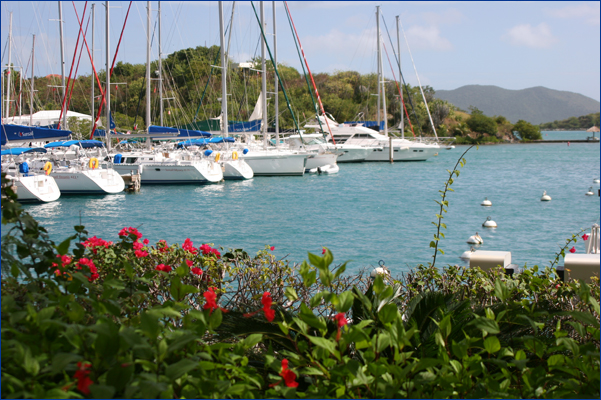
British Virgin Islands
Dec 6th - 16th 2012
Mark your calendars now for a fabulous ASA flotilla
in the British Virgin Islands with flotilla leader
Captain Lucy Newman!
This flotilla has something to offer everyone. We have numerous group gatherings planned including a welcome reception party, treasure hunt, rum beach party and a group dinner at the famous Captains Table restaurant on Virgin Gorda Island at the Bitter End Yacht Club. Experienced skippers and first-time crew are both welcome! Your flotilla leader will be on hand throughout for advice and guidance.
Additional activities that are available beyond the normal sunbathing, napping, relaxing and island hopping on fantastic sailing yachts include scuba diving the famous Rhone, wind surfing, kayaking, renting a Hobie cat or other small keelboat, paddle boarding, beach combing, hiking, and of course SNORKELING, just to name a few!
The flotilla departs from and returns to Tortola, British Virgin Islands. For more information Click here or to register contact Captain Lucy Newman at 281-334-4606. If you are a qualified captain with a group and want to charter your own boat or if you are interested in being a crew member with others, we have boats looking for both.
This trip is designed to accommodate beginners and experienced sailors alike. We look forward to seeing you this December in the BVI's.
|
 Nautical Trivia! How the Leech got its Name by Bob Diamond 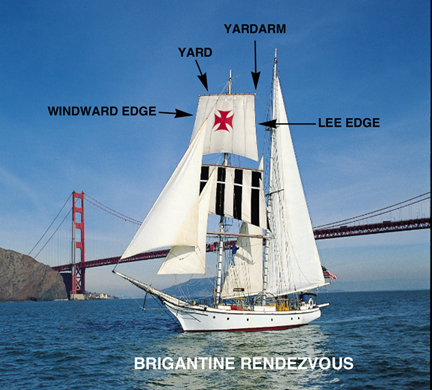 Leech seems like a peculiar word to name a part of a sail but it
makes sense if you go back far enough into sailing history. Going
tback to he late 1700's and early 1800's is far enough. That's
when trade andwarfare was conducted on square-rigged ships.
These plied the tradewinds, which largely meant sailing east or
west. In those days time When the sun was was measured exclusively in accordance with the sun.
When the sun was at at its highest above the horizon, noon was declared and the watch was changed. This is also when the rum rations were given out. (A lot more drinking was done in those days.)
A little about square-rig terminology: The spars that hold up the
square sails from the top are called yards. At each end of the yard
is the yardarm, the part of the yard that sticks out beyond the
edge of the square sail. While sailing, each yardarm can be
defined asither the windward or leeward yardarm depending on the tack being sailed. Each side of the sail is also described as either windward or leeward.
Sailors who have spent a lot of time in harbor bars may have heard the phrase, "The sun is over the yardarm." In its modern context this means its time to drink. Originally it just meant that it was high noon since that's where the sun could be observed if the ship was sailing directly east or west.
Getting back to square sail terminology, we have the windward
edge and the leeward or lee edge of the sail. Anyway, you can see that after drinking all that rum it wouldn't take much time for the term "lee edge" to be corrupted to "leech". The luff and leech of a fore-and-aft sail function much the same way as they do in a square sail, which is why we call the lee edge the leech to this day.
|

NAUTICAL HUMOR
Price of a Pirate Piercing
How much does it cost for a pirate to pierce his
ears?................ A Buccaneer!!!
|

THE SCUTTLEBUTT
Upcoming Events September 2012
Fall is on the way, but the sailing action is far from slowing down! Between flotillas, boat shows, and sailing lessons, ASA has a full slate in September. Know about some great sailing events
going on in your area in September/October 2012 Let us know!
|
|
|
|
|